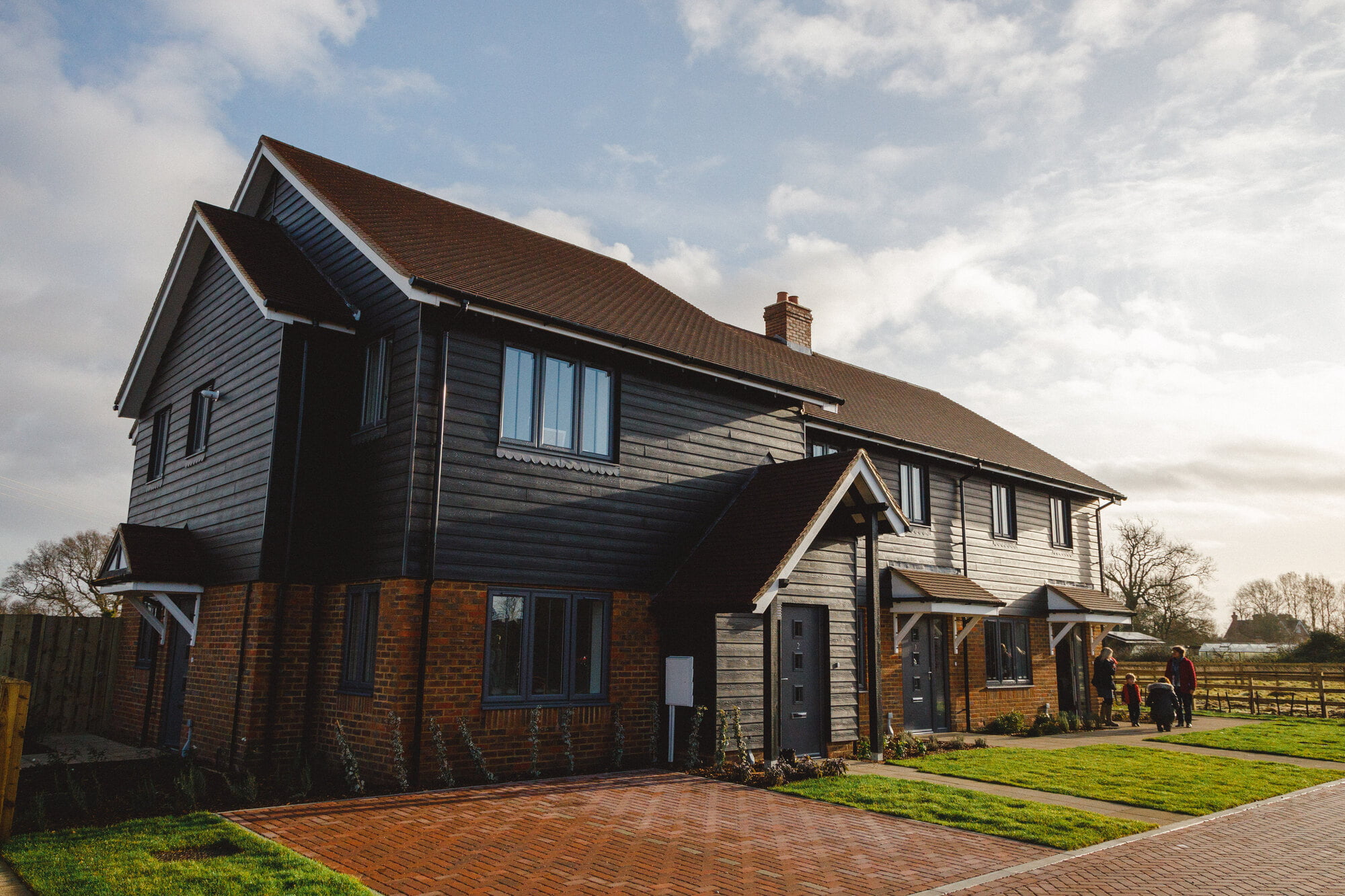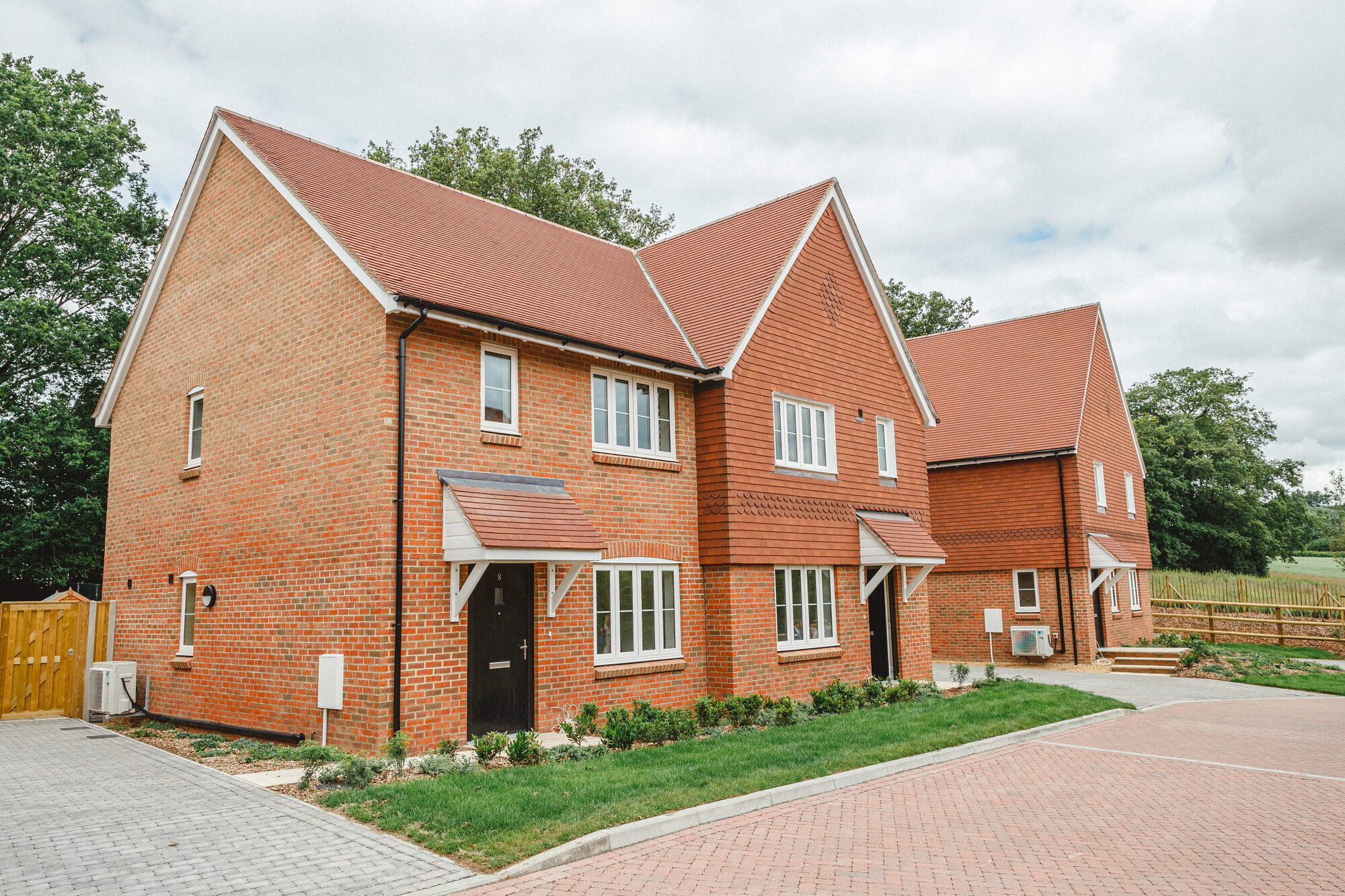
One of English Rural's affordable homes in the village of Warehorne, Kent
Affordable rural homes are an important part of an inclusive and thriving countryside. They provide a safe and secure home for lower income households who live and work there.
Looking at the bigger picture, rural incomes are generally lower, the costs of living is higher, and property values less affordable. This situation is made worse by the fact that rural areas have just 8% of the housing stock as affordable compared to 19% in urban areas. Furthermore, national planning and housing policy favours urban solutions and this continues to compound the affordable housing crisis facing young people in the countryside.
Affordable homes help to support a thriving rural economy and community wellbeing. They supply somewhere for a local workforce to live alongside family and support networks. This is especially important for the land based and agricultural sector which is often reliant on a local workforce. Separately, the issue of farming succession is one which still holds back many traditional and family run farms. Affordable housing can help to address this by supplying somewhere for young farmers to live locally or somewhere secure for older farmers to move to.
This is a ‘catch all’ term and difficult to define with any certainty.
As a starting point you can assume that an affordable home is one which will cost less to buy or rent than an equivalent available through the open property market.
If you apply for an affordable home, you should always make sure you understand all the costs at the start and ask questions about how they are calculated and importantly reviewed in the future.
Affordable homes include affordable home ownership that you can buy either in full or part at less than market value or rented homes where rents have been set at lower than market levels.
Affordable home ownership is mainly shared ownership housing, where you buy a percentage of the property and pay a rent on what is left unpurchased. The definition can also include discounted market sale, where you own the property outright but a restriction locks in a discount on the property price each time it is sold.
The newly announced First Homes are an example of this, with discounts starting at 30%. There are usually restrictions on what you can do with these homes or how they must be sold in the future. Understanding what these restrictions are from the outset is important for anyone who buys one. Mortgages are available on affordable home ownership properties, but not all lenders will offer on them and sometimes those that do charge a higher rate of interest than on market sale properties.
Affordable rent is also a diverse definition. Traditionally socially rented homes were built, and rents were set at approximately 60% of local market rents. More recently affordable rents have been set at 80% of local market rents.
Most affordable rents are capped using a local housing allowance, which is calculated using some local rental market information and establishes the figure at which housing benefit will cover for households who need state financial support towards paying the rent. Any rent charged above the local housing allowance will not be eligible for housing benefit.
In rural areas there are two accepted approaches to building affordable homes:
1. The first is for a percentage of bigger market development built as affordable homes, this is called a developer contribution.
These affordable homes built alongside the market ones are made available to people on the housing waiting list by the local authority, who will usually work with a housing association partner that will own the homes and be the landlord in the longer term.
2. Most rural communities also have another option available to them if they want to build some affordable homes and that is the Rural Exceptions Policy.
This policy, which has been amended by recent planning changes to include Entry Level Exception Sites, allows for small parcels of land to be developed on sites that would not normally get planning permission. The ‘exception’ is made when the local planning policy allows developments that meet local housing needs and makes sure that homes built give priority to local people and remain affordable forever.
The caveat for the ‘exemptions approach is that the value of land made available is much lower than if market homes could be built on it, but more than what it would be worth as agricultural land. Community involvement is essential for Rural Exception Sites, but it is less clear how the community will be able to engage with Entry Level versions at present, if they will need to be at all.
The income generated from rents and sales of affordable housing developments provides the core financing applied to funding new homes.
This income on its own is usually not enough though to make building homes financially viable. Because affordable homes are rented or sold at below market prices, building them is only possible because of alternative finance. Traditionally this alternative finance has come from grants made available from the Government, given to housing associations or sometimes the local authority. Because of the investment of public money, those that receive it are carefully regulated.
Alternative sources to public finances have also become more common over recent years. Examples of this include developer contributions from market sites or cross-subsidy from the sale of market homes. As not-for-profit businesses, housing associations who are the main providers of affordable homes in England will also invest their own internally generated surpluses.
Farmers and landowners are an essential part of the process for building affordable rural homes.
Rural Exception Sites developments rely on a willing local partner to make a small parcel of land available, and to do so at a price that will make the finances of building affordable homes stack-up.
Experience has also shown that farmers and landowners are key members of the community and because of this they can start or lead a conversation about affordable housing. The value can often be longer term for them, as well as considering the needs of the local community, homes built provide somewhere affordable for future workers and family members to live.
Most affordable housing is allocated through partnerships involving the local authority.
Each one will have their own allocations policy in place. If you want to find out more or apply for an affordable home, the first call should be to the local authority to enquire about the eligibility criteria that they apply. The local authority will be able to offer advice over the phone, but most now also have comprehensive guidance available online as well.
Affordable housing is designed to help households who would otherwise not be able to afford to rent or buy a home that meets their needs. The better local authorities will recognise the difference that this means in their rural areas, when compared to their urban areas and make allowances for this.
For young people, particularly those in rural areas unused to dealing with local authorities and the bureaucracy that is entailed, it can be both daunting and off putting to ask for advice and support. If you feel like that then find out if a family member or friend can assist you with the process, but also remember that the local authority is publicly funded and exists to provide services to you as much as anyone else. You will find that most are approachable, helpful and will always take time to make sure your options are fully explained. If you encounter a problem, then consider approaching your local elected Councillor or Parish Council for advice.
The answer to this is ‘more than you think you can’.
Every affordable rural housing development starts with one person asking a question about the need for affordable homes in their community. As a young person committed to the local community, you have a more valid reason than most to ask what housing options can be explored for you locally where these currently do not exist. Put simply, your voice could be a catalyst for the community to explore delivering their own affordable housing development that could help you and others in need of a home they can afford locally.
The best people to ask are the local Parish Council, but if you have influence with local farmers and landowners why not also encourage them to consider making a site available. They can talk to a rural housing association to find out more about how to approach this.

One of English Rural's affordable homes in the village of Bolney, Sussex
Building affordable rural homes takes time and relies heavily on community support.
There are less affordable homes in rural areas compared to urban, so when they are built, they need to be safeguarded for the future. The lack of affordable rural homes is largely down to the sale of older council housing, where residents qualified for the Right to Buy. The Right to Buy saw homes sold off with large discounts but the sale proceeds generated rarely used to replace them.
Newer homes provided by housing associations are not subject to the Right to Buy, although back in 2015 the Government tried to reintroduce this policy for them and a Voluntary Right to Buy is being piloted. This voluntarily arrangement contains rural exemptions to exclude affordable homes built by housing associations.
Importantly, the voluntary arrangement is exactly that, with no legal requirement for housing associations to sell homes on a Right to Buy Basis. There is also a similar policy called Right to Acquire which applies to some housing association homes, but again affordable rural homes are exempted from this. Exempting rural homes makes good sense as evidence shows that for every eight homes sold through Right to Buy in rural areas, only one is replaced.
The Rural Exceptions Site approach to delivering affordable rural homes offers the greatest protection, allowing detailed restrictions to be agreed at the planning stage that will make sure homes remain affordable and prioritise helping the local community in the future.